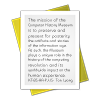Title
Clark, Wesley A. interviewCatalog Number
102738606Type
DocumentDescription
Wes Clark played a seminal role in the early history of computing and computer communications. He graduated from the University of California, Berkeley in 1944 with a degree in physics. As a graduate student, he was furthering his studies at the reactor site at Hanford, WA when he came to the attention of scientists working for MIT Lincoln Laboratory. In 1952, they lured him away to work on the Whirlwind computer Project, the computer at the heart of the SAGE system and the responsibility of Jay Forrester. Whirlwind was the first computer designed to be “interactive;” very different than the prevailing “batch processing” mode of all previous computers. Interactivity required a very fast computer with input and output via a cathode ray tube display that gave nearly immediate visual response to the users’ commands. Clark, as a member of the Advanced Development Group at MIT Lincoln Labs, went on to design the MTC (Memory Test Computer), the TX-0, TX-2 and LINC computers, the latter considered the first personal computer.In the 1950’s, the prevailing model of computing, where large mainframe computers operated in “batch” mode, began giving way to interactive computing. Clark, influenced by his experiences with single user computers, strongly favored the model of interactive computing that came to be known as personal computing; where each user operated a computer of increasing power and capability. In the late 1950’s, an alternative model of interactive computing emerged on the MIT Campus and at BBN, to become known as timesharing. Nevertheless, Clark steadfastly remained unconvinced, even if it meant alienating colleagues.
In 1960, MIT convened the Long Range Computation Study Group to decide the future of timesharing, even the role of computer studies, on the campus. The technical subcommittee recommended acquiring a large computer and converting it to timesharing. The result of the Study Group was the formation and funding of Project MAC in 1963. Clark and the chair of the subcommittee, Prof. Teager, refused to sign the Report. That may have been enough for Clark, for in 1964, he left MIT Lincoln Laboratory for a position at Washington University in St. Louis, MO.
In early 1967, ARPA held a Principal Investigators (PI) meeting at the University of Michigan to which Clark was invited. A central focus of that meeting was the issue of how to connect together different types of large mainframe computers running disparate operating systems. Larry Roberts, who had joined IPTO as the program manager reporting to Robert Taylor, favored having one mainframe in the center of the country to which all computers connected. It was not a perfect solution but it did solve the n-squared problem of connecting every computer to every other computer. At the end of the meeting, the idea struck Clark for a different solution to the problem. In a car ride back to the airport after the meeting, Clark suggested to Roberts, Taylor and Dave Evans the idea of connecting smaller computers together to form the network and connecting the larger computers to these smaller nodes. (It was an idea already tried, and working, in the NPL network.) After Roberts returned to Washington D.C., he soon came to see the merit in Clark’s suggestion, and thus was born the topology of the forthcoming Arpanet. The small computers came to be known as the IMPs, the Interface Message Processors.
Date
1988-07-11Contributor
| Clark, Wesley A., Interviewee |
| Pelkey, James L., Interviewer |
Publisher
Computer History MuseumPlace of Publication
New York, NYFormat
PDFCategory
TranscriptionSubject
Project Whirlwind; Forrester, Jay; TX-0 (Computer); TX-2 (Computer); LINC; MIT Lincoln Laboratory; Washington University; Michigan meetingCollection Title
James L. Pelkey collection : history of computer communicationsCredit
Gift of James PelkeyLot Number
X5671.2010Related Records
| 102746648 | James L. Pelkey collection : history of computer communications |


